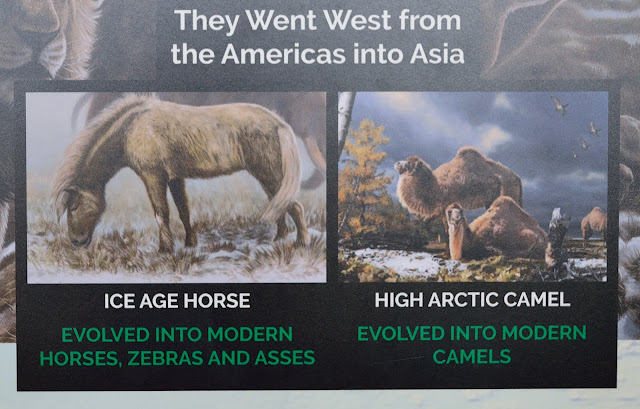Our last day in Whitehorse and the last touristy place we all wanted to go was The Beringia Centre home of the Woolly Mammoth. Of course we started with the 1/2 film which was absolutely excellent.
The lost sub-continent of Beringia dates back to the last ice age. While the rest of Canada lay frozen under massive sheets of ice, a region encompassing eastern Siberia, Alaska, and the Yukon remained untouched by glaciers. Sea levels dropped by as much as 150 metres or 492 feet exposing the floor of the Bering Sea, this was known as the Bering Land Bridge. The land was a grassy tundra, able to support a variety of animals and plant life. The Beringian Steppe was home to a wide range of herbivores and carnivores. Most symbolic of Beringia was the woolly mammoth, predecessor of the modern Asiatic elephant.
Scientists estimate that the world climate began to warm 14,000 years ago. Glaciers melted causing water levels to rise. The low-lying regions of Beringia were flooded and the nutritious grassland of the Mammoth Steppe disappeared along with the grazing herds of Woolly Mammoths. The Woolly Mammoth became extinct about 11,000 years ago in the eastern Beringia. The Giant Beaver like the Woolly Mammoth became extinct 10,000 years ago probably due to the inability to adapt to the climate change. This creature stood 2.5 metres or 8 feet tall and weighed 218 kg or 480 lbs.
The New World’s earliest human inhabitants moved into what is now North America from western Beringia following the various herds of animals. Archaeological evidence show that fully modern humans were living in Siberia (western Beringia) during the last Ice Age 30,000 to 40,000 years ago. However, they may have entered the Americas at the end of the ice age about 15,000 years ago.
After Beringia we went to the Transportation Museum next door but it was closed due to a power failure. Did get to see Whitehorse's version of a weather vane. Built in 1942, serial number 4665, this DC-3 spent the first three years of her life in United States Army Air Force colours. Now this behemoth sits atop a pedestal with her nose pointing into the wind even with the slightest breeze.
Being the last day in Whitehorse we decided to go for a late lunch early supper at Klondike Rib & Steak Restaurant on 2nd Ave in the heart of Whitehorse. The restaurant is housed in the two oldest operating buildings in the Yukon Capital. The dining room was originally opened as a tent frame bakery around 1900. In 1929 the building was purchased by Klondike Airways and became a mail and freight business. Using snowmobiles and caterpillars, the company carried about 110,000 lbs of mail to Dawson City each year. Before 1921 only first-class mail was delivered in the winter. In the 1930’s, the building was a carpentry shop constructing coffins. That business “died” and today it’s a great restaurant specializing in Northern Ocean Fish and Wild Game Meats.
Susan and I started with the Heavenly Halibut Chowder which was served with fresh Bannock. Then I had the grilled halibut while Susan had fried halibut. It was amazing. Bev had the smoked salmon which was also fantastic.
Even though I did not indulge, dessert looked absolutely delightful. Susan had the double chocolate brownie with ice cream. The others had Klondike bread pudding with Jack Gold carmel sauce and ice cream.
After our late lunch the last thing I wanted to see was the two and three story log skyscapers. After WWII, housing continued to be at a premium in Whitehorse as the city expanded. A builder responded to the need in 1947 for housing by constructing the Log Skyscrapers. This was the first privately built multiple-dwelling rental accommodation in Whitehorse. The Log Skyscrapers are in their original location, and continue to provide residences in an increasingly commercial neighborhood.


















No comments:
Post a Comment